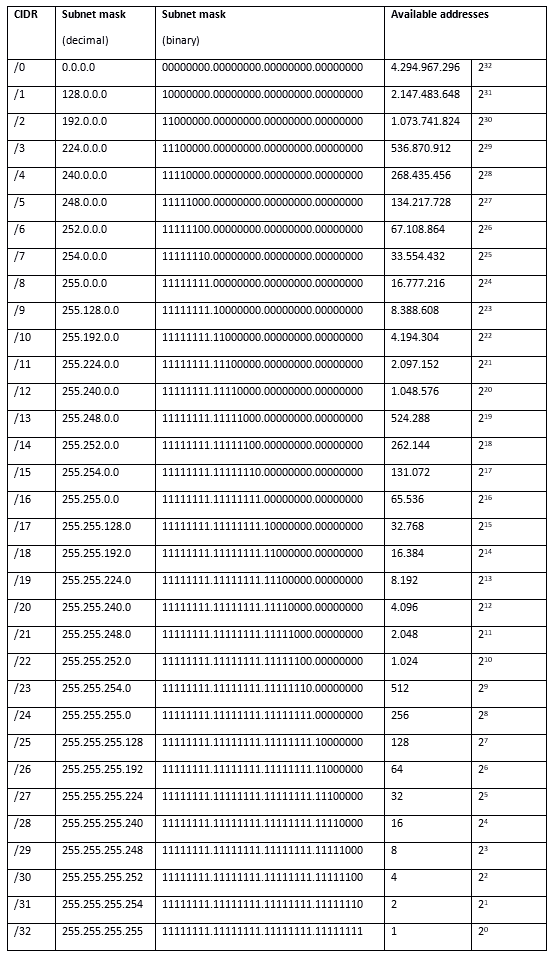

How does classless addressing work?Īt a high level, classless addressing works by allowing IP addresses to be assigned arbitrary network masks without respect to “class.” That means /8 (255.0.0.0), /16 (255.255.0.0), and /24 (255.255.255.0) network masks can be assigned to any address that would have traditionally been in the Class A, B, or C range. This is because network admins get to pick network masks, and in turn, blocks of IP addresses that are the right size for any purpose. Using classless addressing and VLSM, addresses can be allocated much more efficiently. Classless addressing, however, decouples IP address ranges from a default subnet mask, allowing for variable-length subnet masking (VLSM). Each address range has a default subnet mask. You see, with classful addressing, the size of networks is fixed.

The solution would come in 1993, as Classless Inter-Domain Routing (CIDR) introducing the concept of classless addressing. What is classless addressing?Ĭlassless addressing is an IPv4 addressing architecture that uses variable-length subnet masking. Similarly, if it needed just 2 public IP addresses, a Class C would waste 252 (254 usable addresses – 2).Īny way you look at it, IP addresses under the IPv4 protocol were running out, either through waste or the upper limits of the system.ĭid you know? There’s a calculated limit of 4,294,967,296 IPv4 addresses, and they were exhausted on April 21, 2017. Going up to a Class B network means wasting 65,034 addresses (65,534 usable Class B host addresses minus 500). For example, suppose our example organization needs 500 IP addresses. One of the best ways to understand why this was a problem is to consider an organization that needed a network just slightly bigger than a Class C. Addresses were being wasted in too-large blocks, and it was clear there’d be a tipping point where we ran out of IP address space altogether. While classful IP addressing was much more efficient than the older “first 8-bits” method of chopping up the IPv4 address space, it still wasn’t enough to keep up with growth.Īs internet popularity continued to surge past 1981, it became clear that allocating blocks of 16,777,216, 65,536, or 256 addresses simply wasn’t sustainable. What are the limitations of classful IP addressing?Īs you can probably guess, the internet is hungry for IP addresses. Class C addresses are suitable for small networks. Class B is for networks much smaller than Class A, but still large in their own right. The table below details the default network mask (subnet mask), IP address ranges, number of networks, and number of addresses per network of each address class.Īs we can see, Class A continues to use the first 8-bits of an address, and may be suitable for very large networks. However, only A, B, and C are used for network hosts. How? How classful addressing worksĬlassful addressing divides the IPv4 address space (0.0.0.0-255.255.255.255) into 5 classes: A, B, C, D, and E. With classful addresses, we went from just 254 available networks to 2,113,664 available networks.

In 1981, RFC791 and classful addressing came along to help solve that problem. Simply put: we needed a way to more efficiently allocate addresses. After all, there are a lot more than 254 organizations that need IP addresses, and a lot fewer networks that need 16.7 million IP addresses to themselves.

As the internet grew, the inefficiency of allocating IP addresses this way became a problem. Each of those networks contained 16,777,216 different IP addresses. This would have had the effect of limiting the internet to just 254 networks. Prior to classful addressing, the first eight bits of an IP address defined the network a given host was a part of. What is classful addressing?Ĭlassful addressing is an IPv4 addressing architecture that divides addresses into five groups. Let’s take a look closer at both classful and classless addressing, the history and purpose behind them, and the reasons classless addressing has really won out. Need a refresher on how subnets work? Rather than dive into the details here, we’ve put together an in-depth piece that covers subnetting, subnet ranges, CIDR notation and more.


 0 kommentar(er)
0 kommentar(er)
